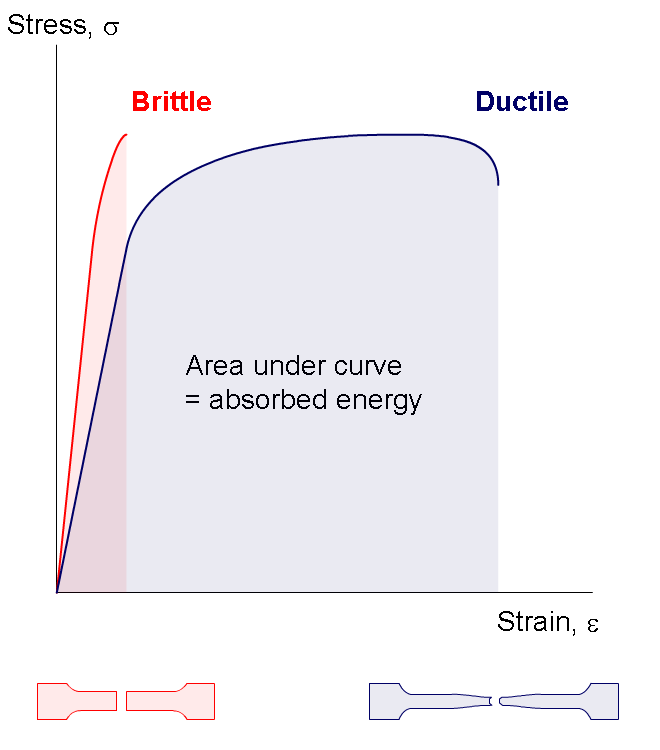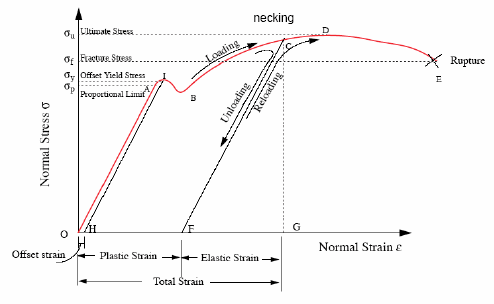Tensile Test diagram for Ductile and Brittle Materials
Measures of Ductility (Elongation and Reduction of Area)
The ductility of a material is a measure of the extent to which a material will deform before fracture. The amount of ductility is an important factor when considering forming operations such as rolling and extrusion. It also provides an indication of how visible overload damage to a component might become before the component fractures. Ductility is also used a quality control measure to assess the level of impurities and proper processing of a material.
The conventional measures of ductility are the engineering strain at fracture (usually called the elongation ) and the reduction of area at fracture. Both of these properties are obtained by fitting the specimen back together after fracture and measuring the change in length and cross-sectional area. Elongation is the change in axial length divided by the original length of the specimen or portion of the specimen. It is expressed as a percentage. Because an appreciable fraction of the plastic deformation will be concentrated in the necked region of the tensile specimen, the value of elongation will depend on the gage length over which the measurement is taken. The smaller the gage length the greater the large localized strain in the necked region will factor into the calculation. Therefore, when reporting values of elongation , the gage length should be given.

One way to avoid the complication from necking is to base the elongation measurement on the uniform strain out to the point at which necking begins. This works well at times but some engineering stress-strain curve are often quite flat in the vicinity of maximum loading and it is difficult to precisely establish the strain when necking starts to occur.
Reduction of area is the change in cross-sectional area divided by the original cross-sectional area. This change is measured in the necked down region of the specimen. Like elongation, it is usually expressed as a percentage.
As previously discussed, tension is just one of the way that a material can be loaded. Other ways of loading a material include compression, bending, shear and torsion, and there are a number of standard tests that have been established to characterize how a material performs under these other loading conditions. A very cursory introduction to some of these other material properties will be provided on the next page.

Ultimate Tensile Strength
The ultimate tensile strength (UTS) or, more simply, the tensile strength, is the maximum engineering stress level reached in a tension test. The strength of a material is its ability to withstand external forces without breaking. In brittle materials, the UTS will at the end of the linear-elastic portion of the stress-strain curve or close to the elastic limit. In ductile materials, the UTS will be well outside of the elastic portion into the plastic portion of the stress-strain curve.
On the stress-strain curve above, the UTS is the highest point where the line is momentarily flat. Since the UTS is based on the engineering stress, it is often not the same as the breaking strength. In ductile materials strain hardening occurs and the stress will continue to increase until fracture occurs, but the engineering stress-strain curve may show a decline in the stress level before fracture occurs. This is the result of engineering stress being based on the original cross-section area and not accounting for the necking that commonly occurs in the test specimen. The UTS may not be completely representative of the highest level of stress that a material can support, but the value is not typically used in the design of components anyway. For ductile metals the current design practice is to use the yield strength for sizing static components. However, since the UTS is easy to determine and quite reproducible, it is useful for the purposes of specifying a material and for quality control purposes. On the other hand, for brittle materials the design of a component may be based on the tensile strength of the material.
